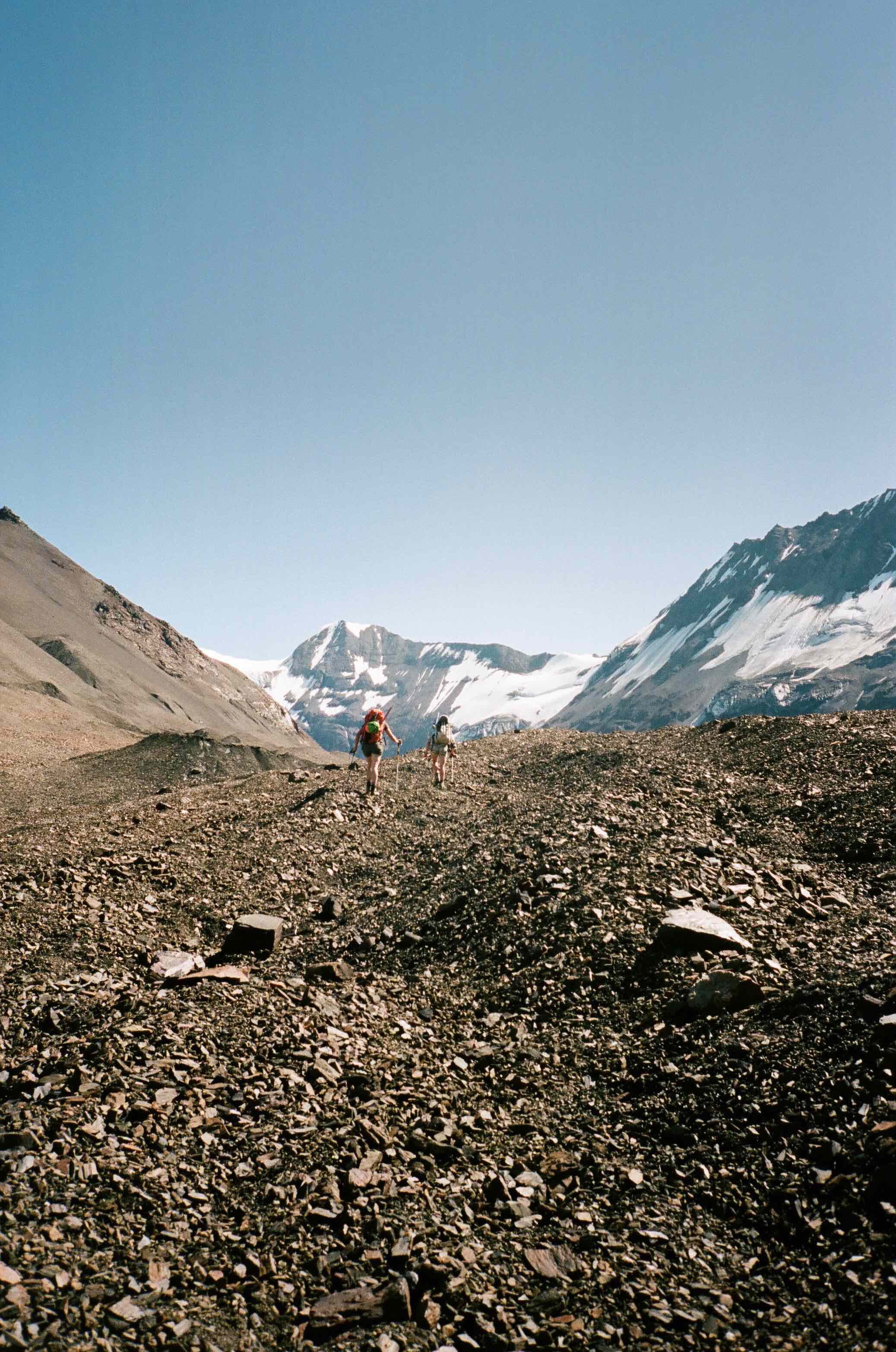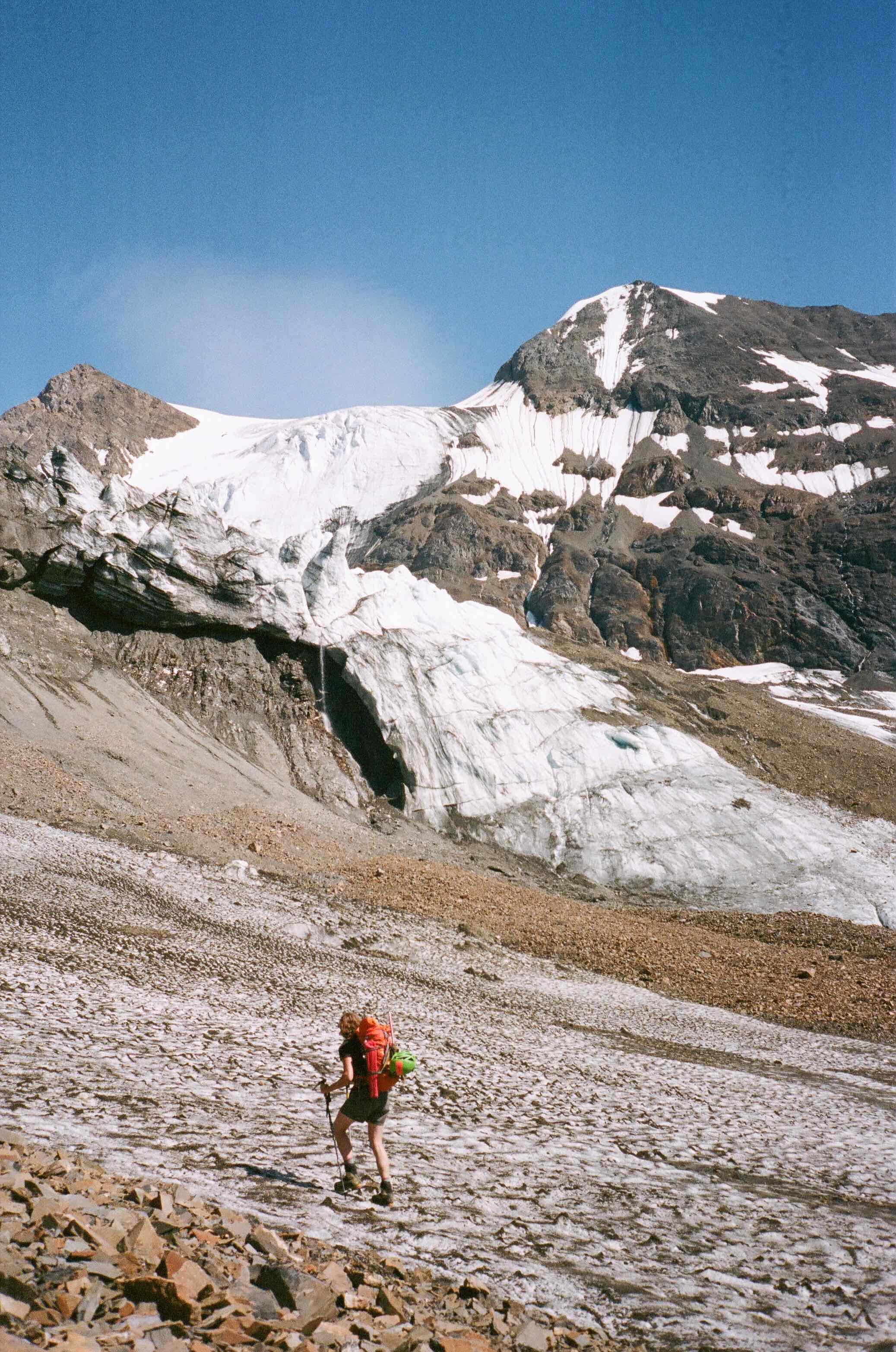Shocks & slides: an attempt on Scott Peak
‘Anyone wanna ride the otter slide?’ I grin at Katherine and Taylor, waiting to see if they’ll roll their eyes or laugh — I’ve already asked this question four times today. Ever the self-appointed joker, I’m attempting to make light of the very scary truth that the Sunset Glacier is disappearing before our eyes and below our feet. Standing beside a narrow seam filled with crystal clear meltwater, I watch the flow gather in a deep, cerulean pool, then surge into a dark tunnel towards the hollow depths of the ice below us. It’s early in the day, but I’m already sweltering under the morning sun. I shudder at the thought of riding the ‘otter slide’ into the darkness below. I snap back to reality, and Taylor grins back at me. I try to swallow my awareness that we probably won’t summit Scott Peak.
‘Alpinism in shorts’ is our motto this weekend. It’s early July during the warmest summer on record in Alaska, and Denali National Park just saw a streak of 80-90 degree days. Our bodies, much like the surrounding peaks, are not acclimated to the heat. We know that summiting the 8,828 ft peak will hinge on snow conditions, especially on the steeper terrain at the headwall of the Sunset Glacier. But we all have the holiday weekend free, and the weather is beautiful despite the extreme temperatures. So we’ve decided to give it a shot.
Wearing short-shorts and tank tops, the three of us poke fun at ourselves as we lash mountain axes to our packs and stuff our glacier kits, ropes, and harnesses inside. We have about 35 miles to cover in the next two days, and our packs are heavy with sleep kits, layers, and climbing gear. We make quick time, nearing the headwaters of the Thorofare River just hours after leaving the park road. There are no trails and few visitors in the backcountry of Denali National Park. Our only interaction of the day is with a lone caribou who prances aimlessly around the valley, nervous in the uncomfortable heat.
Taylor and I share a deep intimacy with the land we’re travelling through: she is a Denali park ranger, and I’m fresh off of nine summers living and guiding in the area. Navigating the trail-free Wilderness feels second nature to us, and we’re excited to share our hearts’ home with Katherine, an accomplished climber from Anchorage. The walking is fast and easy until we reach a choke where the bank of the Thorofare meets the base of the mountains. We decide to sidehill above the river. We move carefully now, aware of the muddy, glacial waters raging below.
It’s on this mountainside that the pangs of climate anxiety I have felt for weeks finally overtake me. In the preceding month, I’ve watched innumerable heat records get shattered across Alaska, and I’ve breathed grey air, thick with smoke from nearby wildfires. I’ve also just returned from a sweltering week at Denali’s basecamp, where I learned from an ongoing glacier study that 60 times more snowmelt occurs today on Mount Hunter’s summit plateau than did 150 years ago. But it’s in this moment, above the banks of the Thorofare, that tears prick my eyes and hairs stand on end as I watch a mountainside crumble before me.
I’m familiar enough with Alaska’s young mountains to know that they are constantly changing. But I also remember that less than ten years ago I wore long underwear all summer in Denali Park. Now I’m in shorts and a tank top at 9:30 pm, watching a mudslide slowly eat away at a mountain. A boat-sized chunk of ice-rich permafrost has been exposed by the slide, and I wonder how long it will last in this summer’s heat. Taylor sees me falter and offers some reassurance, but this moment feels heavy and transformational — like every moment of the rest of my life will be coloured by an acute awareness that the Earth is melting, fast.
On the glacier, the ice is grey and tacky, textured by silt. On day two we pass countless more ‘otter slides’, and comment on how scrappy the glacier looks. I’ve dreamed of this trip for years — a pilgrimage to a peak that bears the same name my father did — and I’ve studied maps and satellite imagery enough to understand that major changes are now taking place. Though I’m anxious about the heat and the state of the planet, I will myself to enjoy the weekend. I’m still in a beautiful, remote landscape with my close friends, chasing a longtime goal.
Our lunch break is punctuated by pops and bangs like firecrackers as the ridges overhead shed loose rock. We’re grateful to have a wide berth from the steep slopes above. The three of us watch in awe as boulders careen downslope, kicking up dust in the midday sun. Doubt creeps in again, but we have a safe travel corridor ahead. So we push on towards the glacial cirque, stopping periodically to watch impressive shows of rockfall.
Nearing the flank of Scott Peak, we navigate a scene of waterfalls, cliffs, and precarious icefalls. At the firn line, we eye the bergschrund we still need to cross. It sags and yawns above us — a menacing mouth, waiting to swallow one of us up. Though we’ve had doubts about our mission since departing the park bus, we’ve pressed on. We’ve come so far. At this point we might as well put boots on the snow. After a brief deliberation we transition to pants, crampons and harnesses, doubtful that we’ll use them. About ten minutes of isothermal snow travel confirms our nagging suspicion: the route ahead is unsafe. We’re here just days too late, and Scott Peak evades us.
I spend much of the return trip processing my climate anxiety. Turning back is the definitive right choice, and normally I’d shrug, ‘Scott Peak will be there next year’. But this time I wonder, ‘will the Sunset Glacier be there next year?’ This is not my first objective to get shut down by Alaska’s extreme climate ramifications. Nor is it the first time I’ve ruminated on the urgency of climate change. In fact, I work in environmental advocacy, fuelled largely by climate justice. But it’s the first time I’ve felt the insurmountable fear that it’s too late to fix the damage we’ve done. This feels different.
My mind turns to the frontline communities that must have processed these fears years ago. I think about homes that have been or will be destroyed by wildfires. And I wonder when climate deniers will eventually feel what I felt on that scree slope in the valley. I know that the movement will continue, and I’ll keep advocating for a just transition to a regenerative economy. Though doubts may creep in, the stakes are too high to give up the fight.
Adrienne Marie Brown writes in Emergent Strategy about shocks and slides in today’s unstable society. Shocks are ‘acute moments of disruption’, and slides are changes which are ‘incremental by nature’. She advises to harness shocks in order to direct slides. My climate anxiety is a shock, and I’m sure I can use it to re-energise my advocacy, hopefully contributing to a slide towards a more sustainable future.
Peace comes and goes as we travel down the valley. I notice my favourite wildflowers dotting the tundra, and I don’t cry when we cross through the mudslide again. We walk in our sports bras, and I wrap my shirt around my head to protect me from the sun. At lunch I watch my friends boulder around on a small cliff near the Thorofare. I’m grateful that they pressed on with me this weekend despite our many doubts. Though we didn’t reach the peak this time, I know that if we try often and push far, our likelihood of summiting increases — a lesson for advocacy, life, and adventure.





